
By Paul Heinerth
June 16, 2011
As my dive team (Jill Heinerth and Brian Kakuk) and I were drifting down to the target area, I could not help but wonder, how did I get here? What turn of events took place in my timeline to put me here, now, in the blue waters of Bermuda? As my mind pondered the answers to these questions, my brain quickly kicked in — reminding me that daydreaming has its time and place, and that now is not such a time.
Watch as Paul Heinerth, Jill Heinerth, and Brian Kakuk prepare their equipment and dive on Natural Bridge Cave. The team encountered a large manta ray during their decompression. Video courtesy of Bermuda Deep Water Caves, NOAA-OER. Additional Footage courtesy of Jill Heinerth. Download (mp4, 21.7 MB).
Rapidly gaining depth as I equalized my ears heading toward Natural Bridge, the selected dive site, my diver mode took over the reverie. First, how do I feel? Knowing what feels right is your first line of defense with the use of rebreathers and doing deep trimix dives. Are all the computer inputs coming in from my rebreather giving me the right info? My heads up display showed a green light. It was happy with the conditions and settings I programmed into it. Good news. Is my dive team all doing what they need to be doing? I looked at them and gave them the “Are you OK?” sign and they quickly replied in a positive manner. Again, good news. It is a good team, very seasoned divers, and we have worked well numerous times in the past. It is reassuring.
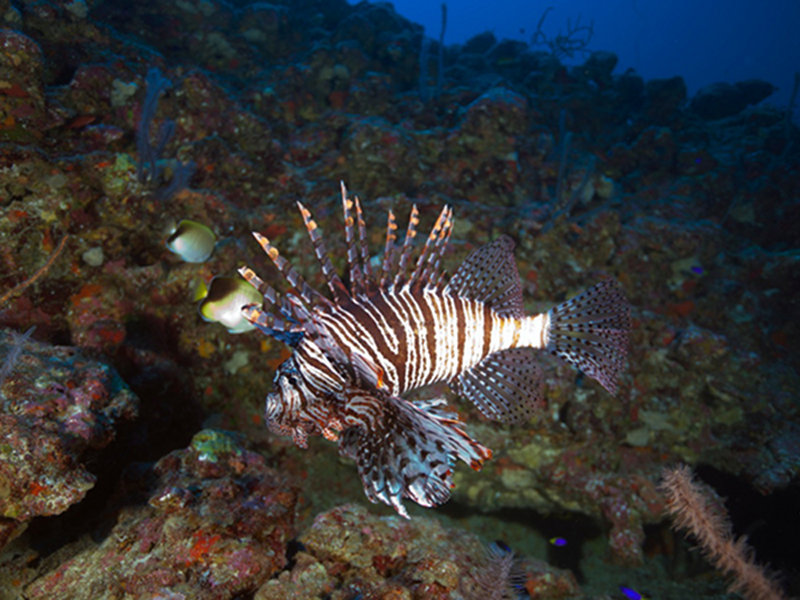
Lionfish and Butterfly fish at depth. Image courtesy of Jill Heinerth, Bermuda Deep Water Caves 2011 Exploration, NOAA-OER. Download larger version (jpg, 776 KB).
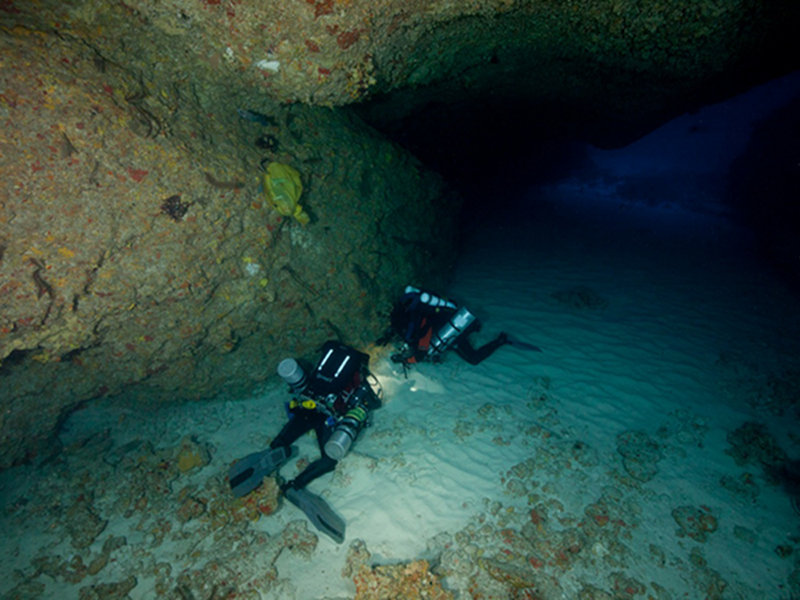
Brian Kakuk and Paul Heinerth at work. Image courtesy of Jill Heinerth, Bermuda Deep Water Caves 2011 Exploration, NOAA-OER. Download larger version (jpg, 795 KB).
The visibility was good. At about 100 feet deep, I started to make out the bottom, still another 115 feet below me. It looked very colorful and I could see many fish swimming all over the bottom. I also felt a drop in water temperature. I was wearing a one piece semi-dry wet suit from Waterproof, but it is two years old and is not as warm as a newer suit. To enhance the effectiveness of the wet suit, I had added a vest with an attached hood. Boy, was I glad, as the temperature dropped again at 200 feet deep. I landed next to our anchor and could see an arch with a considerate swim through only 40 feet away. I made sure all my readouts were good, and quickly covered the distance to the Natural Bridge. As I stared into its gaping mouth, I could see the daylight on the other side. There had been a report of a possible cave with a tunnel inside there. The adrenaline was pumping. I wondered what kind of cave was in there, waiting to be exposed to mankind.
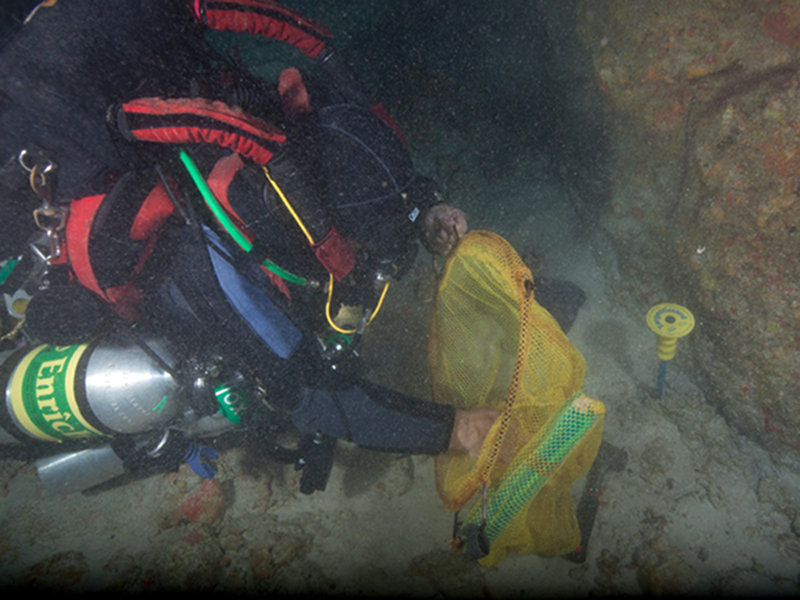
Paul Heinerth collecting geological samples at depth. Image courtesy of Jill Heinerth, Bermuda Deep Water Caves 2011 Exploration, NOAA-OER. Download larger version (jpg, 743 KB).
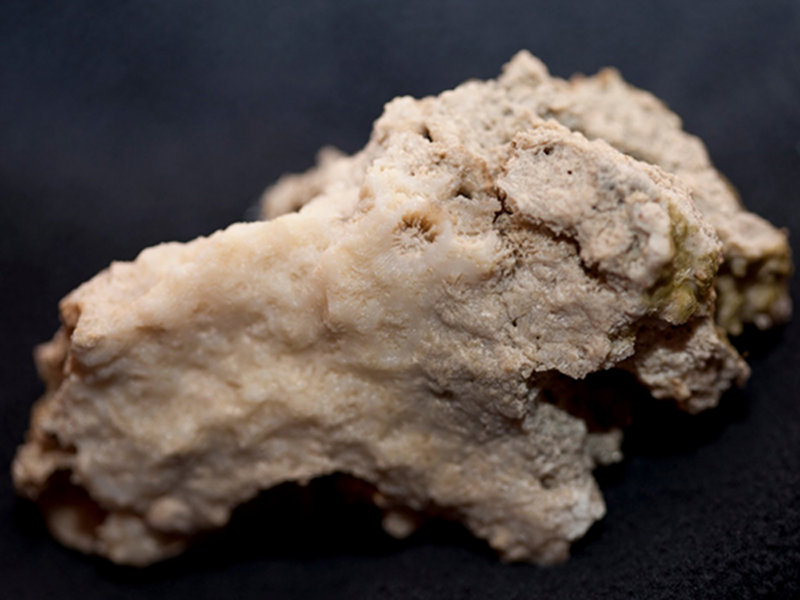
Image of rock sample collected from depth. Image courtesy of Jill Heinerth, Bermuda Deep Water Caves 2011 Exploration, NOAA-OER. Download larger version (jpg, 438 KB).
A shovel lobster was guarding the way. I bent down to say hello and he took off, hitting me in my faceplate and swimming out of sight. I swam in and shone my light all over the inside. There was a tunnel-like feature heading in a northerly direction. As I investigated, I could see the end, maybe 35 feet away. It pinched off. Too bad — no discovery here! I spotted two Caribbean spiny lobsters, two spotted spiny lobsters and three lion fish. Wow, I thought to myself, the lion fish are already here at this depth. They are very successful as an invading species.
Now I needed to get busy to get the measuring tape laid out for a video transect. I quickly spooled out 60 feet and lit up the bottom as Jill and I swam up one side and down the other side. She was recording video; I was providing more illumination. Once done with videoing, I swam in the middle of the arch for some rock samples. We have planned for a 30-minute dive so I needed to get busy with the hammer and chisel. The clock was ticking! I used all my strength and managed to extract some rocks, but the stone was unyielding. Eventually the steel overcame the rock, and samples were collected. Brian was off surveying the cavern formed by this Natural Bridge. I saw him wrapping up his surveying tools. He swam back, motioning that it was time to go. I packed up my tools and samples and started my ascent. Brian and Jill made their way up too.
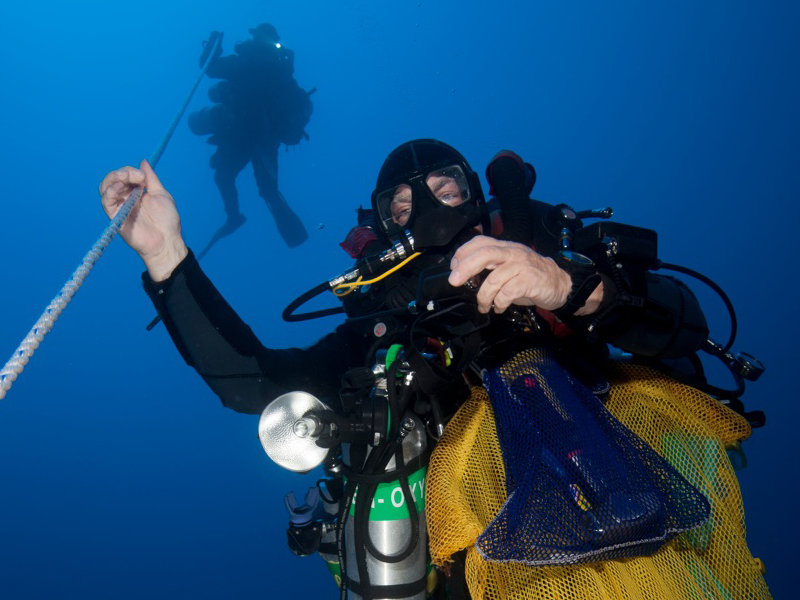
Paul Heinerth making his ascent and following his decompression schedule. Image courtesy of Jill Heinerth, Bermuda Deep Water Caves 2011 Exploration, NOAA-OER. Download larger version (jpg, 624 KB).
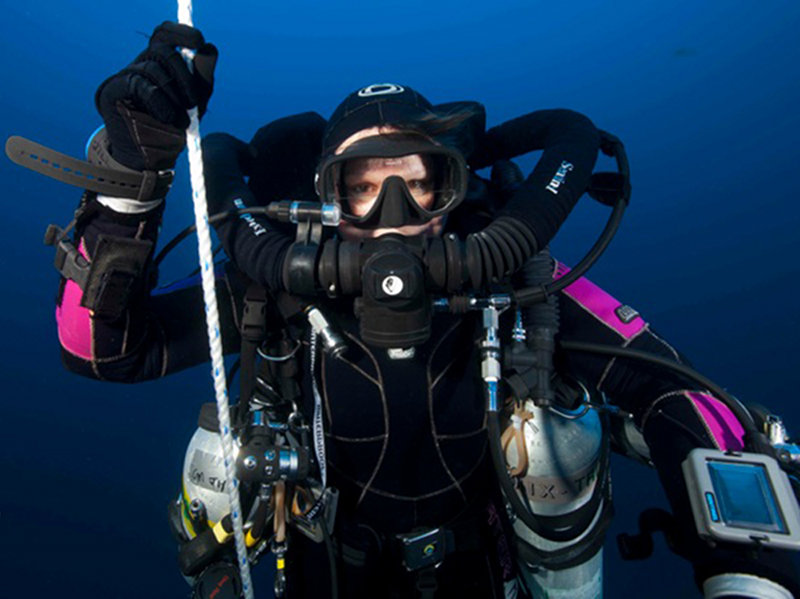
Jill Heinerth waiting for her decompression schedule to end. Image courtesy of Jill Heinerth, Bermuda Deep Water Caves 2011 Exploration, NOAA-OER. Download image (jpg, 85 KB).
At 200 feet, I felt the slight rise in water temperature. It felt good. At 120 feet I needed to stop and observe my first decompression (or "deco") stop. The water temperature increased again, and was well received. At 60 feet, we had a visit during our deco time: a big manta ray swam around us at least three times. Jill managed to video the encounter and Brian swam closer to the visitor. They seemed to be staring at each other for a few moments. The ray displayed rippling motion to us and two big remora were attached right behind its eyes. It looked like Brian is having a dance with the open water creature. After the third pass the blue water flying ray faded off into the distance. The rest of the decompression schedule passed by uneventfully.
After 90 minutes of decompressing, I surfaced and the support divers were all over me like worker bees. I was stripped of all external tanks and hardware, facilitating my climb back in the boat. The dive was over; all went very well.